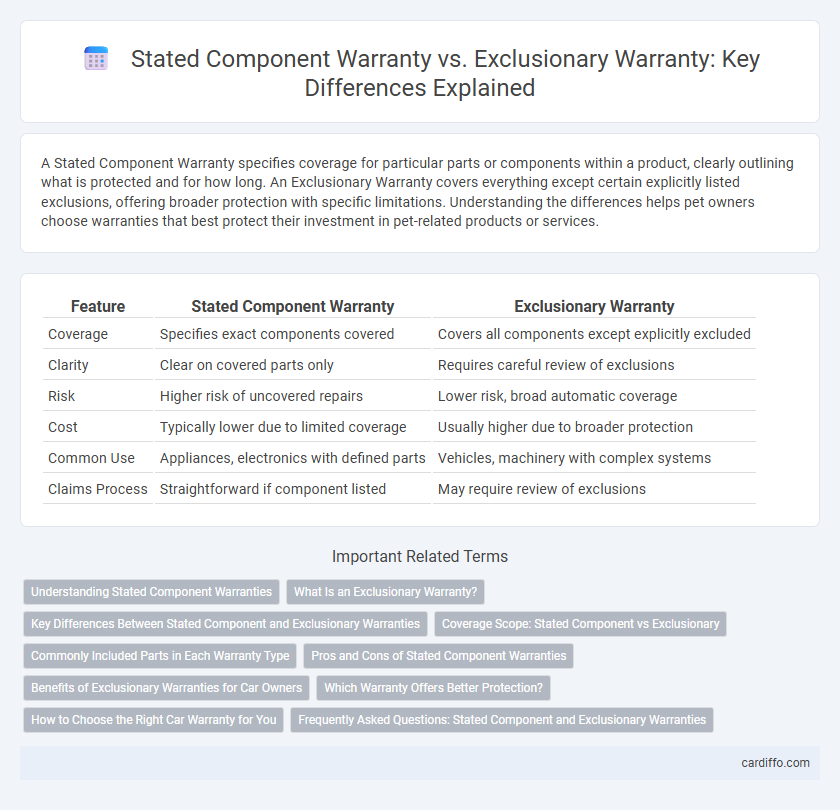A Stated Component Warranty specifies coverage for particular parts or components within a product, clearly outlining what is protected and for how long. An Exclusionary Warranty covers everything except certain explicitly listed exclusions, offering broader protection with specific limitations. Understanding the differences helps pet owners choose warranties that best protect their investment in pet-related products or services.
Table of Comparison
| Feature | Stated Component Warranty | Exclusionary Warranty |
|---|---|---|
| Coverage | Specifies exact components covered | Covers all components except explicitly excluded |
| Clarity | Clear on covered parts only | Requires careful review of exclusions |
| Risk | Higher risk of uncovered repairs | Lower risk, broad automatic coverage |
| Cost | Typically lower due to limited coverage | Usually higher due to broader protection |
| Common Use | Appliances, electronics with defined parts | Vehicles, machinery with complex systems |
| Claims Process | Straightforward if component listed | May require review of exclusions |
Understanding Stated Component Warranties
Stated component warranties explicitly define coverage for specific parts, ensuring clear protection for key vehicle components like the engine or transmission. These warranties specify repair or replacement conditions, limitations, and time or mileage durations, offering precise consumer expectations. Understanding stated component warranties helps buyers compare coverage details and avoid surprises excluded in broader exclusionary warranties.
What Is an Exclusionary Warranty?
An exclusionary warranty limits the coverage by specifying components or types of damage that are not covered under the warranty terms, providing protection only for the stated parts or defects. This contrasts with a stated component warranty, which explicitly covers certain components while excluding others. Exclusionary warranties reduce the manufacturer's liability by clearly defining what is excluded, ensuring clarity for both the consumer and the provider.
Key Differences Between Stated Component and Exclusionary Warranties
Stated component warranties specifically cover designated parts or systems, detailing the exact components protected, while exclusionary warranties cover all parts except those expressly excluded. The key difference lies in the scope of coverage: stated component warranties limit protection to listed elements, whereas exclusionary warranties provide broader coverage with certain exceptions. Understanding these distinctions helps consumers evaluate warranty comprehensiveness and potential repair liabilities.
Coverage Scope: Stated Component vs Exclusionary
Stated Component Warranty specifies coverage for particular parts or components outlined in the warranty agreement, limiting protection to these predefined items. Exclusionary Warranty provides coverage for all vehicle components except those explicitly excluded, offering a broader scope of protection. Understanding the distinction in coverage scope helps consumers evaluate the extent of repair and replacement benefits available under each warranty type.
Commonly Included Parts in Each Warranty Type
Stated component warranties typically cover major parts such as the engine, transmission, and drivetrain, ensuring repair or replacement if defects occur during the warranty period. Exclusionary warranties offer broader protection, including almost all vehicle components except specific exclusions like wear-and-tear items, audio systems, and upholstery. Understanding which parts fall under each warranty type helps consumers assess the level of coverage and potential repair costs.
Pros and Cons of Stated Component Warranties
Stated Component Warranties specifically cover designated parts, offering clear protection and predictable coverage that simplifies claims and repairs. However, these warranties can lead to gaps in overall protection, leaving consumers vulnerable to failures in non-listed components and potentially higher out-of-pocket costs. The limited scope may also result in confusion about what is covered, reducing perceived value compared to broader exclusionary warranties.
Benefits of Exclusionary Warranties for Car Owners
Exclusionary warranties provide car owners with broader and more comprehensive coverage by specifying only what is not covered, rather than listing all covered components. This approach reduces ambiguity and often results in fewer out-of-pocket repair expenses, enhancing overall ownership satisfaction. Car owners benefit from increased protection against unexpected mechanical failures and greater transparency in warranty terms.
Which Warranty Offers Better Protection?
Exclusionary warranties provide broader protection by covering all components except those specifically excluded, whereas stated component warranties limit coverage to only the listed parts. Consumers receive more comprehensive security with exclusionary warranties, reducing out-of-pocket repair costs for unforeseen failures. Therefore, exclusionary warranties generally offer better protection compared to stated component warranties.
How to Choose the Right Car Warranty for You
Choosing the right car warranty involves understanding the difference between stated component warranties, which cover specific parts like the engine or transmission, and exclusionary warranties that protect nearly all components except for explicitly excluded items. Analyze your driving habits, vehicle usage, and potential repair costs to determine if broad coverage or targeted protection suits your needs better. Review warranty terms carefully to ensure coverage aligns with your car's model, age, and anticipated maintenance expenses.
Frequently Asked Questions: Stated Component and Exclusionary Warranties
Stated Component Warranties specifically list covered parts, providing clear protection for identified components while excluding others. Exclusionary Warranties, on the other hand, cover all components except those explicitly excluded, offering broader coverage with defined limitations. Understanding the differences helps consumers determine warranty scope and anticipate repair costs accurately.
Stated Component Warranty vs Exclusionary Warranty Infographic

 cardiffo.com
cardiffo.com